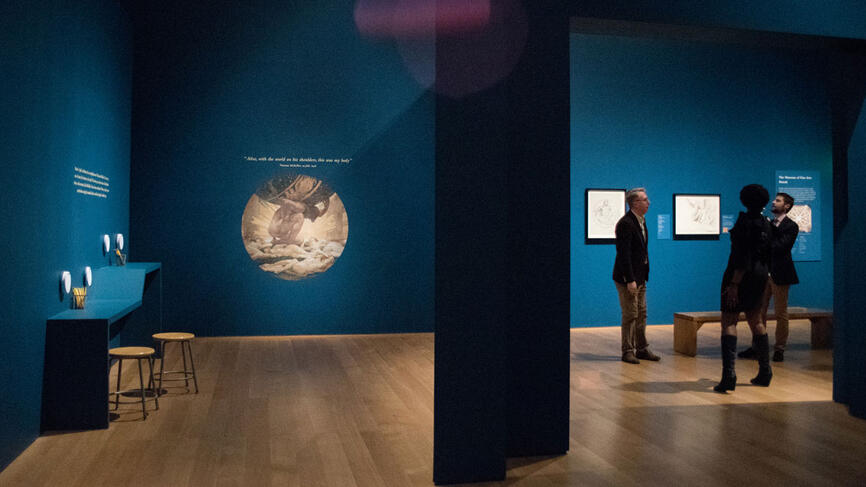
Wellesley’s Connections to the Isabella Stewart Gardner’s New Exhibition “Boston’s Apollo”
When visitors enter the Museum of Fine Arts, Boston, they crane their necks to better view the mural on the museum’s rotunda ceiling, which depicts a series of mythological figures by 19th-century artist and portrait painter John Singer Sargent. For more than a century, visitors have been drawn to this work, one of Sargent’s most public displays, but many may not know that its connection to Boston goes deeper than its location in the city.
That connection is Thomas Eugene McKeller, born in 1890, a young black elevator operator at Boston’s Hotel Vendome who served as Sargent’s primary model for the figures depicted in the MFA’s rotunda and other similar masterpieces.
For the first time, Sargent’s original drawings of McKeller are on display together at the Isabella Stewart Gardner Museum’s exhibition Boston’s Apollo: Thomas McKeller and John Singer Sargent.
Wellesley’s own Nikki Greene, assistant professor of art, and Paul Fisher, associate professor of American studies, contributed essays to the exhibition’s catalogue, which takes a closer look at the man who inspired so many of Sargent’s works.
Listen as they take us through the exhibit, offering insights on the drawings, the relationship between Sargent and McKeller, and the significance of this body of work in conversations about class, race, and gender in the city of Boston.
Though the exhibition is closed for the foreseeable future in response to the coronavirus (COVID-19) pandemic, in addition to this virtual tour, more information about the art can be found on the Isabella Stewart Gardner Museum website and through the exhibition catalogue.





NIkki Green: Hi, I am Nikki Green and I'm here with my colleague Paul Fisher at the Isabella Stewart Gardner Museum and we are inside of the exhibition Boston's Apollo, Thomas McKeller and John Singer Sargent. I think for most of us who have been to the Museum of Fine Arts, one of the highlights of the MFA in Boston is the set of murals by John Singer Sargent. When you look at those beautiful figures and mythological figures, there's no trace that the main protagonists in those images are actually the embodiment or embodied by Thomas McKeller because he served as a model for many of those striking figures. Paul Fisher: Sargent is very well researched. There are volumes and volumes and volumes about Sargent. and one of the things that both Nikki and I have faced when we were thinking about writing about these things is there's almost nothing been written about McKeller before now, very little bits here and there. This is typical of many artist's models, that they have not been a focus until the last couple of decades for art historians to look into their lives and into their dynamics with the painters that paint them. Paul Fisher: But in this case here was a person who was exceptionally erased. And what's in the volume that Nikki and I contributed to is more than there ever has been about this figure. There are what, five letters by him that we've been able to uncover, which give us a sense of his voice. One of the approaches that both of us took is this idea of his being immersed in history, being immersed in the history of Black Boston. Paul Fisher: And that enabled us to say more than we would otherwise have wanted to say because we didn't want to assume that we knew this person. And we still feel very deferential toward the mystery of somebody who really helped Sargent create some of these very beautiful images that are so important to public art in Boston. NIkki Green: It gives our students a chance to really think more critically about what does it mean to be not just a model, but what does it mean to be a Black citizen of Boston in the early 20th century? Because when you look at the MFA murals, you don't see a Black man. I feel like we're able to rewind a bit. We're able to lift the veil. We're able to see a figure as he were with these drawings. Paul Fisher: I love this section too because it implicitly compares and contrasts this final product, the decorations in the Museum Rotunda, which you can see when you go into the MFA with this private studio drawings. There was a strong distinction between his public art and his private art. And if you ask me, his private art is so much better. Instead of reducing it to a cliche of Greek Mythology or the arts as Greek Mythology, they make us look at these issues that for a long time people didn't want to look at. NIkki Green: My students got a chance I think between reading the scholarship and then seeing the artwork and experiencing the work in the galleries, they actually have a process of what it means to do serious research. They have a better understanding of who writes the history, when is that history of obscured, when do we have a chance to uncover a number of histories? If that's the history of what does it mean to be a black man in Boston in the 19 teens and 1920s what kind of work could you find that's there to understand that he could be at the Hotel Vendome one minute and then at the end of the day transition over to Sergeant's studio. NIkki Green: That alone is a history of labor in Boston, in early Boston, early 20th century Boston. And then we also have this idea, we are so wedded to the idea of an art historical canon and Sargent's right up there in terms of our canon of who makes the greatest works of American art. People around the world appreciate and know John Singer Sargent's work. And we also have this real window into John Singer Sargent in Boston With this very intimate relationship with Thomas McKeller. Paul Fisher: It's so cutting edge. That's the other thing that I would say about this. I mean, last year there was a big show on The Black Model from Monet to Matisse by a wonderful curator from Columbia, whose name is Denise Murrell. Yeah, she's terrific. And I took Wellesley students to that in Paris last spring. It was in Paris at the Orsay, and I took a bunch of Wellesley students there and they were floored by the social content of this. Paul Fisher: Some of them were better versed in art history than others. Nikki's feeling that she ought to have been there as she should. NIkki Green: I should have been as a consultant. Paul Fisher: Absolutely. But, but I think Wellesley students really appreciated this. And so that was a bombshell of an exhibition, as far as I'm concerned. One of the most important that has happened in recent times. And this likewise, is important in the same way. It's really revealing some of the complex racial history and sexual history that underpins some of these sort of glorious icons of art.



